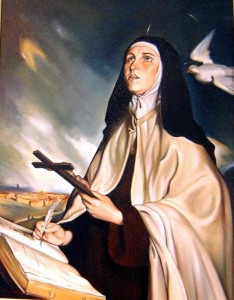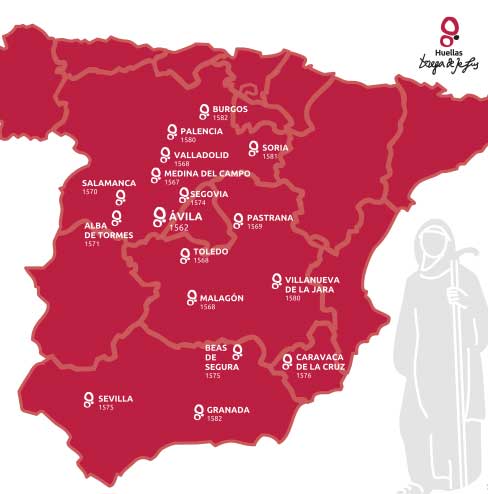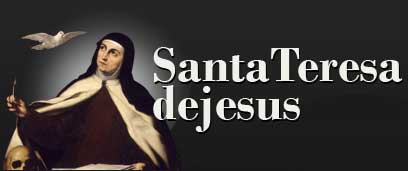Who is Saint Theresa?
She was called Teresa of Ávila and then she was known as St Theresa of Jesus. Born in 1515, this woman became a well-known Spanish Catholic Carmelite nun and she was considered to be a founder of the Discalced Carmelitas along with John of the Cross. She was a great writer and her books are about Christian mysticism and Christian meditation. St Theresa´s main writings, produced for didactic purposes, are: “Autobiography”, “El camino de Perfección” (the way of Perfection), “Meditations of Song of Songs”, “Castillo interior” (Inner castle) and “Relationships”. When St Theresa died, her cult became popular in Spain owing to the religious claim and debate of national patronage of Saint James versus Saint James Matamoros (Moor-layer). That´s to say, in the 1620s Spain debated who should be the country’s patron saint; the choices were either the current patron, Saint James Matamoros (“Moor-slayer”) or a combination of him and the newly canonised Saint Teresa of Ávila. Teresa’s promoters said Spain faced newer challenges, especially the threat of Protestantism and societal decline at home, thus needing a more contemporary patron who understood those issues and could guide the Spanish nation. Santiago’s supporters (Santiaguistas) fought back viciously and eventually won the argument, but Teresa of Ávila remained far more popular at the local level.

St Theresa established new houses of her order, and in this effort and later visitations she made long journeys through nearly all provinces of Spain. Between 1567-1571 convents of her order were established at Medina del Campo, Malagón, Valladolid, Toledo, Pastrana, Salamanca and Alba de Tormes. She was also given permission to set up two houses for men who wished to adopt the reforms. The she convinced John of the Cross and Anthony of Jesus to help with this. In this way, they founded the first convent of Discalced Carmelite Brethren in November 1568 at Duruello. She founded, eventually, seventeen convents.
Who wants to follow St Theresa footprints on the Camino?
Now pilgrims and tourists can follow the “footprints of St Theresa” route, which passes through seventeen cities where she founded convents. “Footprints of St. Theresa” is one of a series of events to take place between 15 October 2014 and 15 October 2015. It consists of a tourist route and pilgrimage that crosses 17 cities in four Autonomous Communities in which the saint founded convents. The itinerary begins in her native city, Ávila, and passes through Medina del Campo, Malagón, Valladolid, Toledo, Pastrana, Salamanca, Alba de Tormes, Segovia, Beas de Segura, Seville, Caravaca de la Cruz, Villanueva de la Jara, Palencia, Soria, Granada and Burgos (Camino francés).

Miguel Ángel García Nieto, the mayor of Avila, explained that the route is a pilgrimage of a “touristic and cultural” nature, which entails “a new way of getting to know Spain,” through the 17 convents that St. Theresa founded in those cities, which will be the “milestones” of this itinerary, which gets underway on March 28. Marca España and the Avila city government have signed an agreement for promoting and disseminating information about the Fifth Centenary of the birth at Avila of St.Theresa.
There are three key destinations along the “Footprints”: Avila: The city walls and the Interpretation Centre are obligatory stops along the route in Avila, as is the convent that occupies the site of St, Teresa’s birthplace. Likewise, the church of St. John, where she was baptized, and the convent of Our Lady of Grace, where she was educated. Alba de Tormes: St. Theresa arrived here in 1582. The route suggests a visit to the Convent of the Annunciation, which houses her holy sepulchre, and then to the convent of the Carmelite Fathers, the church of St. John of the Cross and the Church of the Isabel Mothers. And Salamanca: The last stop on the route includes visit to the New Cathedral; to the Sky of Salamanca and the Fray Luis de León classroom at the university; the Convent of ST. Steven and the House of St. Theresa.
“The relevance of St. Theresa of Jesus is, at the dawn of the twenty-first century, perhaps greater than it has ever been. In the twentieth century, historical and literary works began to be published which strengthened her spiritual, doctrinal and literary dimension and specifically underscored the sociological and anthropological aspects which derive from her position as a woman,” says the royal decree by which the Commission was created.
Buen Camino, amigos!
Anxo Saco



Comments
Zarah
This is much appreciated! I studied in a school where St. Theresa of Avila was our patron saint. I am so happy to note that a route in Spain is dedicated to her and her legacy. Looking forward to another chance to walk.
Davidmaria
Is the route well-marked and safe for a solo female pilgrim?